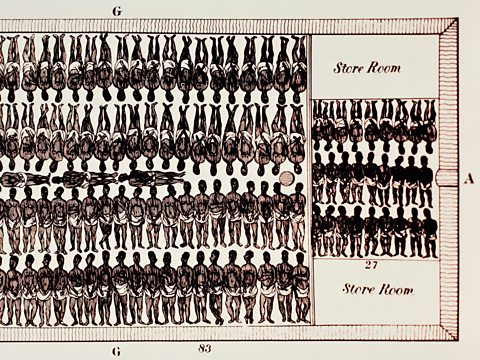The Middle Passage
Conditions
The voyage from Africa to the New World of the Americas was called the Middle Passage. Slave ships usually took between six and eleven weeks to complete the voyage.
Slave ships made large profits by carrying as many enslaved people as possible across the Atlantic to sell at auction. There were two methods of loading the ship:
Tight pack - this method involved packing as many enslaved people into the hold as possible.
It was expected that some would die, but a large number would still survive the voyage. A shipŌĆÖs hold was cramped - only five feet high, with a shelf running round the edge to carry yet more enslaved people. People were loaded in so close together that one captain described them as being 'like books on a shelf'.
Loose pack - fewer enslaved people were loaded, giving them more space to lie out.
More slaves survived the voyage so less money was lost.

Cramped
- Enslaved people were unable to go to the toilet.
- Sickness quickly spread.
- Enslaved people were all chained together. If someone died, the body could remain in the hold for hours, still chained to other living people.
- The hold was dark, stuffy and stinking. The heat and the foul air were so bad that a candle would not burn.
Food
- Enslaved African people were often unable to digest the food carried by the European crew, making the sickness worse.
- Sick people were often denied food and left to die.
Mistreatment and humiliation
- The crew's treatment of enslaved people was often horrific ŌĆō women could be subject to rape.
- Some enslaved people were forced to dance on deck for an hour a day to keep them fit. Any resistance was dealt with harshly by floggings from the crew.
- Some enslaved people chose to take their own lives rather than endure such brutal treatment.
Sickness
Sickness on board a slave ship would often spread to the crew as well, killing many. The death rate among the enslaved people however, was horrific. It is estimated that 15ŌĆō16 per cent of enslaved people died on the Middle Passage.
Slave Trade Act, 1788 - Dolben's Act
In 1788, British MP William Dolben put forward a bill to regulate conditions on board slave ships. He described horrors of enslaved people chained hand and foot, stowed like herrings in a barrel
and stricken with putrid and fatal disorders
.
The Slave Trade Act, 1788 was passed and controlled the number of captive people a ship was permitted to carry, according to its weight.
DolbenŌĆÖs Act also ordered all slave ships to carry a doctor who had to keep records about the enslaved Africans on board.
These doctors received bonuses according to the number of Africans who survived the journey. Conditions however remained appalling.